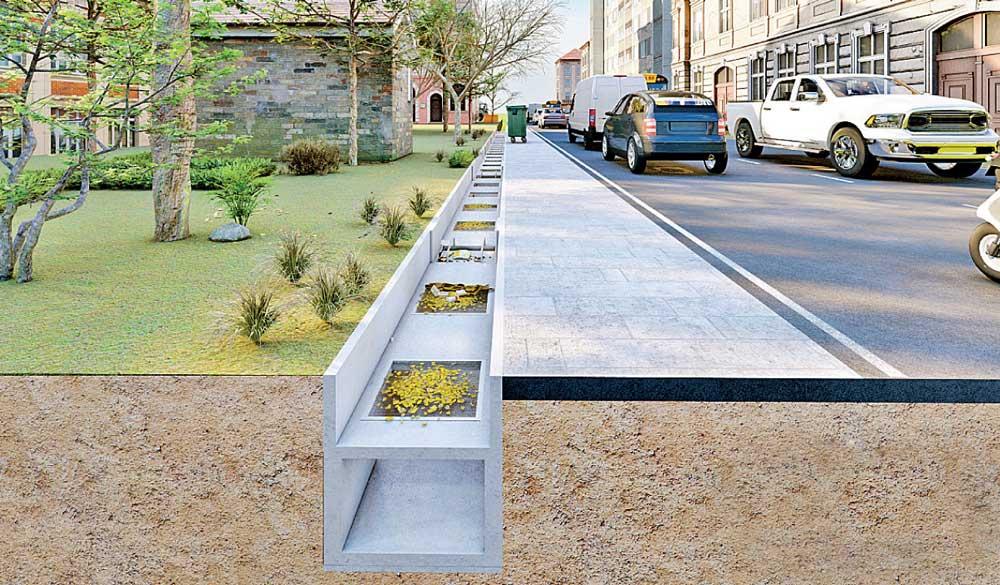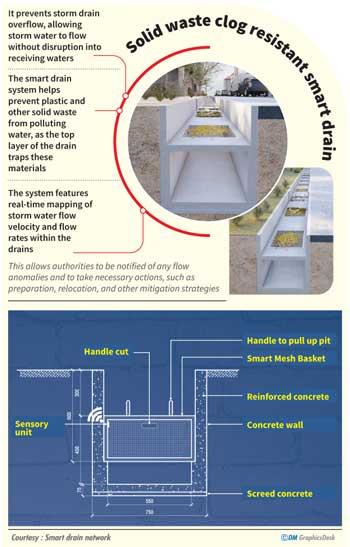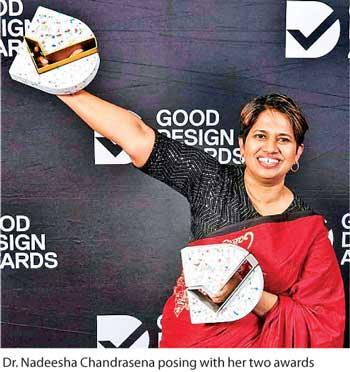02 Oct 2024 - {{hitsCtrl.values.hits}}

Urban innovator Dr. Nadeesha Chandrasena recently received two accolades at the recently concluded 2024 Australia Good Design Awards; the Gold award in the Engineering design category and ‘Best in Class’ award, for building the world’s first dual-layer, clog-resistant smart storm drain.
Dr. Chandrasena holds a doctorate in Civil Engineering, specialising in a part of open-channel hydraulics and carries over 14 years of experience in environmental consulting, storm water management and urban planning. She is a town planner by profession and believes that urban planning is a “versatile discipline which attracted her for its ability to shape civilization.
 It was a childhood experience that inspired her to develop a smart drain. “I saw clogged drains and overflowing storm drains, even after a mild rain,” Dr. Chandrasena said in an interview with the Daily Mirror. “As kids, travelling to school by bus and walking home from the bus stop, these overflowing storm drains made things difficult. We had to remove our shoes and walk through muddy water. I always wanted to find a solution for that. My inspiration was that childhood experience,” she said.
It was a childhood experience that inspired her to develop a smart drain. “I saw clogged drains and overflowing storm drains, even after a mild rain,” Dr. Chandrasena said in an interview with the Daily Mirror. “As kids, travelling to school by bus and walking home from the bus stop, these overflowing storm drains made things difficult. We had to remove our shoes and walk through muddy water. I always wanted to find a solution for that. My inspiration was that childhood experience,” she said.
For Dr. Chandresena, this had been a persistent dream throughout the years. “After studying urban planning and understanding human interactions with space and the environment, I structured a solution and am now working on it. This is just the start,” she added.
A first in the world
The world’s first dual-layer, clog-resistant smart storm drain is engineered to trap solid waste while ensuring the free flow of stormwater. “This system helps cities manage stormwater efficiently, preventing flooding and making urban areas safer and more resilient during heavy rainfall,” Dr. Chandrasena explained.
 Dr. Chandrasena and her team had been developing the smart drain system technically from December 2013 to date. Speaking about the beginnings of this project Dr. Chandrasena said that she started her doctoral research at Universiti Teknologi PETRONAS, Malaysia, in October 2017, under the supervision of Dr. Khamruzaman bin Wan Yusof and Dr. Zahiranisa Mustafa. “Later, I got together with some Facebook friends—Dr. Ransirimal Fernando, Sujeewa Kokawala, Janaka Prasanna Kuruppu, and Darshana Wimukthi where we created a Facebook group to develop this design. In 2020, we applied for a patent, which was granted in 2022. Our team remains together to this day, continuing to develop the system.” She said.
Dr. Chandrasena and her team had been developing the smart drain system technically from December 2013 to date. Speaking about the beginnings of this project Dr. Chandrasena said that she started her doctoral research at Universiti Teknologi PETRONAS, Malaysia, in October 2017, under the supervision of Dr. Khamruzaman bin Wan Yusof and Dr. Zahiranisa Mustafa. “Later, I got together with some Facebook friends—Dr. Ransirimal Fernando, Sujeewa Kokawala, Janaka Prasanna Kuruppu, and Darshana Wimukthi where we created a Facebook group to develop this design. In 2020, we applied for a patent, which was granted in 2022. Our team remains together to this day, continuing to develop the system.” She said.
The Australia Good Design Awards showcase the very best in design and innovation to a worldwide audience. Every year the Awards attract cutting-edge design projects from across the globe celebrating the very best in design, architecture, engineering, research, fashion and social impact. This year’s theme ‘Design Effect’ underscored the crucial role design plays in shaping better products, services, spaces and experiences while driving the transition to a more sustainable, less carbon-intensive future.
“After applying for the Good Design competition, we needed to build an actual unit and commission it. For that, I received support from Kosala Indrasiri of Sanmark Solutions, Sahan Chathuranga of Sanota, Dinusha Shan of MCD Engineering, Thisura Senarath, and Lakshan Romesh, who all helped make this happen,” said Dr. Chandrasena.
Dr. Chandrasena’s smart drain project involves a certain degree of human involvement where the drainage system ‘alerts’ human operators when intervention is needed. “Human involvement is necessary for a catastrophic moment such as a flood and mitigation is better conducted with human supervision,” she added further. “Our idea was not to eliminate human involvement, or to function as a fully autonomous system. In fact there is no need to take human involvement out of a major system like a city drainage system. Our idea was to figure out cumbersome and costly activities which may not get proper attention just for being so. We want to make the drainage system take care of these and alert human operators where the intervention is needed. That would make operations efficient, much less costly and issues will not fall out of human attention,” she added.
The smart drain system therefore provides provide real-time data to intervene in drain clogs and overflows, but the system points exactly to the places where the clogs are, for immediate intervention. This, compared to the traditional human involved search for clogs and delayed detections, can make a big difference in urban flood mitigation.
Managing storm water in Colombo
It is a known fact that Colombo gets flooded even during slight rainfall and causes severe inconvenience to city dwellers. According to Dr. Chandrasena, floods in Colombo occur due to several complex issues including the fact that the city itself is a wetland and lies in a low-lying area, making it more prone to floods.
“Colombo is also a compact city with a high population density, leading to significant human interactions and construction activities. Unplanned construction has encroached upon natural drainage paths, further contributing to the problem. Clogged drains, especially at certain aggregation points, are also a major cause of flooding in Colombo,” she added.
The smart drain system can help manage storm water in Colombo in three key ways, Dr. Chandrasena explained. “First, it prevents storm drain overflow, allowing storm water to flow without disruption into receiving waters. Second, the smart drain system helps prevent plastic and other solid waste from polluting water, as the top layer of the drain traps these materials. Third, the system features real-time mapping of storm water flow velocity and flow rates within the drains. This allows authorities to be notified of any flow anomalies and to take necessary actions, such as preparation, relocation, and other mitigation strategies. This is how the smart drain system can contribute to flood management and mitigation in urban areas like Colombo.” She added.
When asked why town planning is important for cities in future Dr. Chandrasena said that planning is important for cities to ‘make the spaces liveable’. “Liveable spaces enhance the quality of life. We need planning to manage urban growth, optimize resources, address environmental challenges, and promote economic growth. As cities face rapid population increases and climate concerns, effective planning becomes even more critical. Emerging technologies like AI, and geospatial tools can revolutionize this process by enabling predictive analytics, optimizing energy use, enhancing infrastructure through smart cities, and allowing for sustainable designs. AI-driven insights, along with technologies like VR, drones, and 3D printing, can help planners create cities that are efficient, resilient, and capable of adapting to future challenges,” she explained further.
Clogged drains are an issue in compact cities mainly in low and lower middle income countries which are densely populated and congested. In such countries urban drainage is not considered as an important feature in town planning. The next step of this smart drain project is the Build Your Own City Drain initiative. This is a pro bono concept that would be initiated from Sri Lanka itself. This is where a group of interested volunteers would get together to construct this drain in their respective cities. A smart drain wouldn’t be required everywhere and it is only required in places where dirt is likely to be accumulated and eventually clog drains.
As the world is looking at ways to transform their cityscapes into livable spaces, Sri Lanka should also consider some of the easily available options. In that sense, this smart drain system is perhaps a good start. Sustainability is an ongoing practice, said Dr. Chandrasena while adding that cities can begin implementing it at any time. “There is no specific starting point or date for adopting sustainable practices. The City of Colombo faces many issues that need to be addressed through proper planning. While everyone wants to settle in Colombo, the city can no longer accommodate new settlements or settlers. The best approach would be to develop the public transport network and reduce the city’s density by promoting new settlements in areas that are accessible via high-quality public transport. This would help ease the pressure on prime urban areas while allowing for smarter, more sustainable growth,” she said.
An open call for collaborations
When Dr. Chandrasena grabbed the two awards, many social media users acknowledged her efforts to provide an effective solution to urban stormwater management. When asked whether she would be interested to implement the project in Sri Lanka she responded in the affirmative and said that the product has now been fully developed. “We didn’t try approaching the government or authorities without having a commissioned product. However, now that we have a working product and public support, we are ready to move forward with building it, and we welcome any opportunity to collaborate with the public and the government to implement this innovation in Sri Lanka,” she added.
On that positive note, Dr. Chandrasena also extended her gratitude to Planner K.D. Fernando, a retired Senior Lecturer from the University of Moratuwa who had supported her at the beginning of her career, even financing her research presentation overseas. She recalled his lessons on the ‘Human Settlements in Planning’ module which were key to her design. Dr. Chandrasena also expressed her gratitude to Professor Emeritus Willie Mendis for his role in establishing the Bachelor’s program in Planning in Sri Lanka.
26 Dec 2024 15 minute ago
26 Dec 2024 2 hours ago
26 Dec 2024 3 hours ago
26 Dec 2024 5 hours ago
26 Dec 2024 6 hours ago